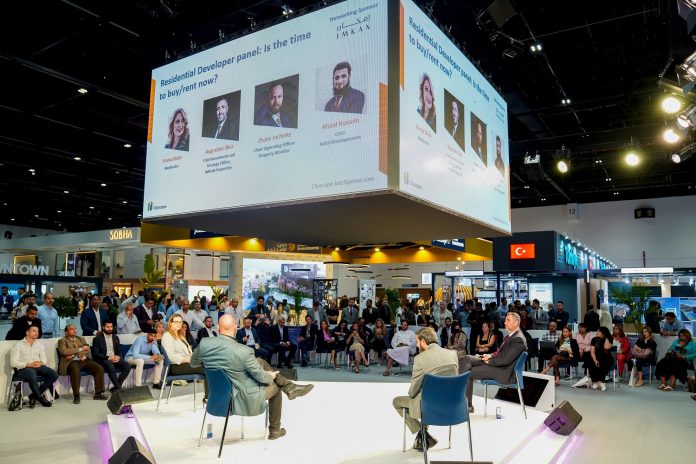
- Emirate’s real estate market offers huge potential for homebuyers and investors, leading figures agree at Cityscape Intelligence Talks.
- Developers can do more to meet demand for affordable villas and townhouses.
- Cityscape underlines appetite for Dubai real estate with exhibitors closing deals worth more than AED 100 million during the first two days alone.
Time to rent vs time to buy, and just what to buy, were some of the trending topics up for debate in a top-level gathering of the region’s leading real estate professionals at Cityscape, the UAE’s largest property finding event.
In a thought-provoking day of discussion at the Cityscape Intelligence Talks, the region’s leading content platform, industry leaders concluded that while Dubai’s real estate industry has matured into a developed marketplace complete with extensive opportunities, investors and homebuyers should really focus on where they want to put their money.
On the exhibition floor, Cityscape underlined the appetite of investors and end users to own property in Dubai with key exhibitors reporting big business. Sobha Realty revealed it closed deals worth more than AED 100 million during the first two days of the three-day event, which ended on Wednesday at Dubai World Trade Centre.
“We started the pre-launch of Sobha Hartland One on day one of Cityscape, with so many people interested. There’s so much appetite now, the Sobha stand has been packed with visitors and interested parties,” said Francis Alfred, Managing Director, Sobha Realty.
With the Dubai real estate industry flourishing, the Cityscape Intelligence Talks was a big draw as sector stakeholders sought insight for key figures. In a panel discussion titled ‘Buying Into Dubai: hunting yields, migration to the suburbs and what’s next for property buyers?’ Matt Gregory, COO of Houza.com; Sam McCone, Managing Director, McCone Properties and Safura Abasniya, CEO Aston Pearl Real Estate Broker, agreed the Dubai real estate market has untapped potential, but more work is required by developers to meet demand, while homebuyers and investors must think what it is they really want to buy.
“The opportunity is there for investors. If we look at Q3, 50 per cent of buyers were cash buyers,” said Matt Gregory, adding there will always be a requirement in the market for affordable villas, yet there remains a shortage in supply. “There’s a distinct lack of affordable villas and townhouses that you might class as local rather than further out. There’s an opportunity there for developers to take stock and decide that is the way the industry needs to go.”
Safura Abasniya added: “Today, one out of 10 launches are villas or townhouses while 90 per cent are apartments. In three years’ time Dubai’s demand for family homes will increase exponentially, so, if you are investor, these would be the properties you need to look out for.”
The third member of the panel, Sam McCone, countered: “Dubai is considered a safe haven. There is opportunity here for end users and investors, but it depends on what investors are looking for. Some properties have increased by 150 per cent and I don’t believe that is sustainable. However, there are options for affordable communities, which can add value to homebuyers. Dubai offers a wide range of options and opportunities, but investors need to be smart as to where they place their money.”
Earlier, in an insightful residential developer panel, Afzaal Hussein, CEO of Azizi Developments, told delegates: “There is a lot of interest in Dubai. It is time for the city to launch as much as possible and capitalise on that. There is opportunity to invest anywhere. Yes, you can get a villa for 200-300 million dirhams if you want, but you can also get a studio or one-bed for 150,000-300,000 dirhams.”
With the supply of family homes a consistent topic of discussion, Zhann Jochinke, COO of Property Monitor, added: “There is not enough inventory. This year we have seen 38,000 new projects come to market but only 5 per cent are villas, about 15 per cent are townhouses while the rest are apartments, so supply isn’t meeting demand.”



































